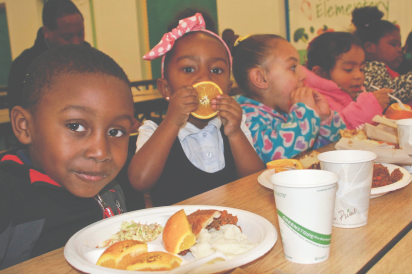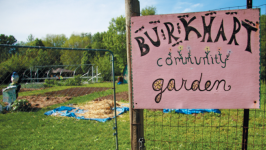Locally Sourced School Lunches
School lunches have a bad reputation. Just ask my teenage sons. The meat looks suspicious, the vegetables are overcooked and even the “normal” food, like pizza or tacos, doesn’t look all that normal. Tacos in a bag? Rectangle pizza?
And that’s saying nothing about the nutritional value. If a school lunch doesn’t look or taste good, how can it be healthy—especially if it comes from a freezer with no clues to its origin? Here’s a thought: what if the food served in schools was grown and produced locally? Certainly, that would be healthier, and it seems like an easy enough concept. But is it?
California serves the country’s first organic school lunch
Conscious Kitchen, a Sausalito, California, nonprofit, began as an offshoot of the student-led activist group Turning Green. Founded by Judi Shils, the group is comprised primarily of college students, who became engaged in sustainability causes around the world. “A board member said we’d lost our footing in our own community,” Shils explains, and that led them to consider the food being served in their local public schools. Hence, Conscious Kitchen was born.
In the beginning, Conscious Kitchen partnered with well-known chefs in the Bay Area to organize Eco Top Chef competitions in local middle schools. The goal was to create a meal costing $2.25 or less per person, which follows the Conscious Kitchen’s five guiding principles, FLOSN: fresh, local, organic, seasonal and non-GMO.
“Everyone looked at me like I was out of my mind,” Shils says. But during the events, the chefs created good meals with budgetary constraints and within the guidelines. And the students, says Shils, were “in heaven.” The chefs also made enough food for the parents and administrators to try, and everyone loved it. It was then, Shills says, they knew they were onto something and soon, a one-week pilot program was born where chef Justin Everett prepared and served an entirely FLOSN menu for Bayside MLK Jr. Academy’s 156 students. That successful week prompted the school superintendent to give the Conscious Kitchen program a green light, and Bayside MLK began offering an entirely FLOSN menu.
Within a couple of years, Conscious Kitchen expanded to Willow Creek Academy, a public charter school with 350 students in grades K–8, and soon after, the Sausalito Marin City School District became the first in the country with an organic lunch. This year, Conscious Kitchen is partnering with Good Earth Natural Foods School Lunch Program to provide FLOSN meals to 14 additional Marin County Schools. In addition, two schools in the West Contra Costa Unified School District have committed to work with Conscious Kitchen during the 2017–2018 school year.
Are locally sourced lunches affordable?
One of the biggest hurdles Shils has had to overcome is cost. “I’m tired of hearing that it’s unaffordable, particularly from moms,” she says. All the schools she works with are public schools where some, if not all, of the students qualify for free and reduced-price lunches. According to the Conscious Kitchen website, the program serves two meals cooked from scratch each day at a cost to students of $1.35 for breakfast and $2.85 for lunch. During our interview, Shils said the actual cost to prepare a lunch is closer to $4.50.
Since the USDA reimburses only up to $3.33 for lunch and $2.04 for breakfast for children on the free and reduced-price program, schools have to make up the difference with fundraising, increased participation by children who can afford to pay or other school budget allocations.
“But we can’t afford not to do this,” Shils says. “Our food elevates the children. It levels the playing field. If they can’t think and are sick, they aren’t going to do anything in life.”
But that’s California. Would such a program work in the Midwest? Shils says yes.
“How will we do it in Iowa or Indiana?” she asks. “Everything’s not going to be perfect. If cost is a problem, we have to figure out how to get around it. But I believe where there is a will there’s a way. We have to figure out how to get there.”
What if a school wants to commit to some of the FLOSN principles, but doesn’t believe they can get the buy-in of school administrators or can’t afford to follow the guidelines completely? For Shils, modifying the local, seasonal and fresh guidelines may be necessary when working in parts of the country that don’t have as much agricultural or have shorter growing seasons. But the organic principles are non-negotiable.
“There’s no compromise,” Shils says. “We might not be for every school. Other companies might be a better fit. But I don’t work with schools who don’t go all out.”
Can we do this in Indiana?
The Indiana Farm to School Network (IFSN) offers a different approach to providing a locally sourced, healthy lunch for kids.
Rather than mandate specific guidelines for what public schools should serve (beyond the USDA requirements), the IFSN acts as a support system to help local farms, markets and schools work together to better the health of children, farms, communities, the environment and the economy. But strictly regulated procurement rules prohibit food service directors from exploring purchases from local farmers. Still, the IFSN compiles lists of certified local growers and producers, provides procurement guidance for the informal and micro buying programs that making buying from local farms easier and offers training for food service directors and employees to help them create menus using fresh, local products.
But will children eat fresh, local food when it’s served?
According to Indiana Department of Education (IDOE) Wellness Specialist Maggie Schabel, the first step many schools take toward transforming their lunch program is to offer tasting events, where farmers are invited in to talk about local products and children are given the opportunity to try them. In addition, educating students about growing methods and the nutritional value of a vegetable or fruit, and possibly even allowing them to grow it in a school garden, makes them more willing to try new things, Schabel says.
Purdue University Urban Garden Program Manager Ginny Roberts recommends schools introduce a farm-to-school meal program by introducing one fresh, local food at a time, rather than trying to transform the whole plate.
Jessica Smith, whose This Old Farm food hub provides locally raised and processed meats to schools, echoed the sentiment. She often suggests schools start with one meal a month, then one meal a week, and so on, rather than attempting to go all in from the start.
“If the goal is 100 percent, they’d quickly find failure and stop altogether,” she says. “Instead, they should look for progress along the way. In a sense, each introduction to connection with the land for these kids is a success.”
And schools are beginning to make progress. Logansport Community School Corporation served kale smoothies on their lunch line during the 2015 Farm to School Month with kale grown in their school gardens and based on recipes developed by the high school culinary class. Bartholomew Consolidated Schools use a variety of fresh, local produce from local farmers, orchards and their own school gardens in their cafeteria serving lines. And this past year, Tippecanoe Valley School Corporation students raised their own cows, took them to This Old Farm for processing and used the meat in the school cafeterias.
Whether Indiana schools eventually achieve Shils’ FLOSN guidelines or simply help kids understand how to make better food choices, providing a locally sourced, healthy lunch in our public schools goes beyond logistics.
“It’s bigger than food,” Shils says. “Really, it’s about everything. We’re raising a new generation of school leaders with a different mindset who are more open to new ideas.”
Want to serve fresh, local foods in your school?
Shils recommends beginning with an assessment of your school’s current program by asking:
- What are the costs?
- How many children are paying full price?
- How many receive free or reduced-price meals?
- What food is currently being served?
Then, to successfully transition to your new lunch program, you need to get everyone on board: administrators, parents, local producers and especially food service directors, which Shils says often are the hardest to convince. She suggests organizing a food council of others interested in helping win support from key stakeholders.
Next, identify your school’s priorities and establish one or two goals. The IFSN suggests identifying menu items you’d like to transition to local products and finding a farmer or distributor to connect you to local items.
Finally, implement your program by pooling resources, planning for potential roadblocks, following procurement guidelines and possibly even organizing fundraisers to help cover transition costs. Also, host a tasting event, sponsor an eco-chef contest or test your program with one meal or a week of meals to give everyone a chance to interact with the food and get a sense of what a better school lunch program could look like.
While Conscious Kitchen currently exists only in California, Shils hopes to establish a nationwide network of schools that model a FLOSN meal program. Contact Conscious Kitchen through ConsciousKitchen.org for more information. You can also contact the Indiana Farm-to-School Network, FarmToSchool.org/our-network/Indiana, to learn about Hoosier schools that provide locally sourced, healthy lunches for kids










